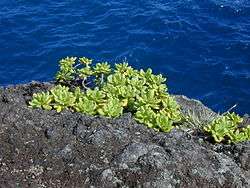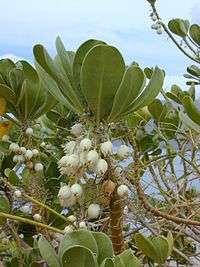Scaevola taccada
| Scaevola taccada | |
|---|---|
 | |
| Scaevola taccada in its typical habitat; Maui, Kanaha Beach | |
.jpg) | |
| S. taccada flower | |
| Scientific classification | |
| Kingdom: | Plantae |
| (unranked): | Angiosperms |
| (unranked): | Eudicots |
| (unranked): | Asterids |
| Order: | Asterales |
| Family: | Goodeniaceae |
| Genus: | Scaevola |
| Species: | S. taccada |
| Binomial name | |
| Scaevola taccada (Gaertn.) Roxb. | |
| Synonyms | |
| |
Scaevola taccada, also known as beach cabbage, sea lettuce, beach naupaka, naupaka kahakai (Hawaiian), magoo (Divehi), merambong (Malay) and ngahu (Tongan) is a flowering plant in the family Goodeniaceae found in coastal locations in the tropical areas of the Indo-Pacific. It is a common beach shrub throughout the Arabian Sea, the tropical Indian Ocean and the tropical Islands of the Pacific.
Description
It is a large bush reaching up to about 4 m in height typical of littoral zones where it grows very close to the sea exposed to the salt spray, usually on sandy or pebbly soils.[2] Leaves are slightly succulent, about 20 cm long, closely alternate and crowded at the stem tips. They are glabrous with a fleshy-looking yellowish green color. The fruits and flowers are white. Scaevola taccada blooms the whole year round and the flowers have a fan-like shape which gives them the name fanflower or half flower. The fruits float in seawater and are propagated by ocean currents, this bush being one of the pioneer plants in new sandbanks in tropical areas.[3]
Distribution
The coastal areas and beaches of Okinawa, Taiwan, Southern China, Vietnam, Malaysia, Philippines, Indonesia, East Timor, Northern Australia, Polynesia, Melanesia, Micronesia, East Africa, Madagascar, Mauritius, Seychelles, Oman, Yemen, India, Maldives, Burma, Thailand, Cambodia, Chagos Islands, Comoros, Réunion.
Habitat
Scaevola taccada typically grows directly on the beaches of tropical coasts with a preference for beach crests on coral sands. It grows within in the salt spray area and it is amongst the first pioneer plant colonisers on tropical Atolls and sandbanks. Besides seeds, it is easy propagated from cuttings.
It prefers well drained sandy soils and it is a very salt tolerant scrub. Scaevola taccada is sometimes found growing in loose plant communities with coconut palms, soldierbush, beach morning glory, beach gardenia, several pandanus species, beach calophyllum followed by portia tree, sea almond, beach hibiscus, Cordia subcordata and others. The plant is often featured prominently on tropical island postcards and wallpapers.
Scaevola taccada habitat, Seychelles |
Seashore habitat of Scaevola taccada on a beach in the Seychelles. |
 Scaevola taccada habitat, Maldives |
_001.jpg) Scaevola taccada habitat, Kuramathi, Maldives. |
 Scaevola taccada bush growing on rocky volcanic soil. |
Use
In some islands of the Pacific, Scaevola taccada is used to prevent coastal erosion as well as for landscaping. It is also planted on the beach crests to protect other cultivated plants from the salt spray. Parts of the plant are also used in Polynesian and Asian traditional medicine.[4] It has also been proven to be "an excellent remedy as antidiabetic, antipyretic, antiinflamatory, anticoagulant and as skeletal muscle relaxant without any adverse reactions" by the department of pharmacy of Annamalai University, India. [5]
Historically in the Maldives the leaves of this bush were often used as famine food.[6]
Invasive Species
In the United States ( Florida, Puerto Rico, US Virgin Islands) as well as many other Caribbean nations and the Bahamas, Scaevola taccada has become an invasive species, pushing away the native Caribbean Scaevola plumieri species from its native habitat.[7]
Leaves, flowers and fruits
Scaevola taccada leaves and flowers |
 Closeup of a flower from Andhra Pradesh, India. |
 Scaevola taccada fruits; Maui, Kihei. |
 Leaves damaged by the larvae of the Udea litorea moth |
 Clusters in Ap Lei Chau, Hong Kong. |
See also
References
- ↑ Plant List - Scaevola taccada (Gaertn.) Roxb.
- ↑ An Assessment of Post Tsunami Restoration and Conservation Initiatives in Coastal Stretch of Matara - IUCN-Sri Lanka Country Office
- ↑ Hyland, B. P. M.; Whiffin, T.; Zich, F. A.; et al. (Dec 2010). "Factsheet – Scaevola taccada". Australian Tropical Rainforest Plants. Edition 6.1, online version [RFK 6.1]. Cairns, Australia: Commonwealth Scientific and Industrial Research Organisation (CSIRO), through its Division of Plant Industry; the Centre for Australian National Biodiversity Research; the Australian Tropical Herbarium, James Cook University. Retrieved 16 Mar 2013.
- ↑ GISD - Scaevola sericea (shrub)
- ↑ - Amelia Earhart May Have Survived Months as Castaway
- ↑ Eating on the Islands - As times have changed, so has the Maldives' unique cuisine and culture
- ↑ Invasive species in The Bahamas an overview
External links
| Wikimedia Commons has media related to Scaevola taccada. |
| Wikispecies has information related to: Scaevola taccada |